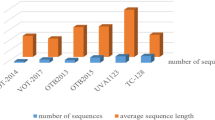Abstract
This paper proposes a tracking failure detection method based on time reverse error distance. Corner feature is used as interest point to perform the task. The algorithm consists of three stages. First, the corner feature is extracted from the image. Then, a tracker produces a trajectory by tracking the point in the previous frame to the current frame. Second, the location of point in the current frame is initialized as a reference point. The validated trajectory is obtained by tracking-reverse the reference point in the current frame to the previous frame. Third, both trajectories are compared with each other, if they are significantly different, the reversed point is considered as an incorrect. To evaluate the performance of this method, an object tracking method is performed. A set of points is initialized from a rectangular bounding box. These points are tracked and evaluated using the proposed tracking failure detection method. The correct tracked points are used to estimate bounding boxes in consecutive images. The performance results show that the proposed method is efficient for human detection and tracking in omnidirectional images.
Access this chapter
Tax calculation will be finalised at checkout
Purchases are for personal use only
Preview
Unable to display preview. Download preview PDF.
Similar content being viewed by others
References
Gavrila, D.M., Munder, S.: Multi-cue Pedestrian Detection and Tracking from a Moving Vehicle. International Journal of Computer Vision 73(1), 41–59 (2007)
Dalal, N., Triggs, B.: Histograms of Oriented Gradients for Human Detection. In: IEEE Conference on Computer Vision and Pattern Recognition (CVPR) (2005)
Hoang, V.D., Vavilin, A., Jo, K.H.: Fast Human Detection Based on Parallelogram Haar-Like Feature. In: The 38th Annual Conference of The IEEE Industrial Electronics Society, Montreal, pp. 4220–4225 (2012)
Hariyono, J., Hoang, V.-D., Jo, K.-H.: Motion Segmentation using Optical Flow for Pedestrian Detection from Moving Vehicle. In: Hwang, D., Jung, J.J., Nguyen, N.-T. (eds.) ICCCI 2014. LNCS, vol. 8733, pp. 204–213. Springer, Heidelberg (2014)
Tomasi, C., Kanade, T.: Detection and Tracking of Point Features. In: Proceedings of Fourteenth International Conference on Pattern Recognition, vol. 2, p. 1433 (1998)
Hariyono, J., Wahyono, Jo, K.H.: Accuracy Enhancement of Omnidirectional Camera Calibration for Structure from Motion. In: International Conference on Control, Automation and Systems, Korea (2013)
Hariyono, J., Hoang, V.D., Jo, K.H.: Moving Object Localization using Optical Flow for Pedestrian Detection from a Moving Vehicle. The Scientific World Journal (2014). http://dx.doi.org/10.1155/2014/196415
Hoang, V.D., Le, M.H., Jo, K.H.: Hybrid cascade boosting machine using variant scale blocks based HOG features for pedestrian detection. Neurocomputing 135, 357–366 (2014)
Hariyono, J., Hoang, V.D., Jo, K.H.: Human Detection from Mobile Omnidirectional Camera Using Ego-motion Compensated. In: 6th Asian Conference on Intelligent Information and Database Systems, Bangkok (2014)
Kalal, Z., Matas, J., Mikolajczyk, K.: P-N Learning: Bootstrapping Binary Classifiers by Structural Constraints. In: CVPR (2010)
Avidan, S.: Ensemble Tracking. IEEE Trans. Pattern Analysis and Machine Intelligence 29(2), 261–271 (2007)
Babenko, B., Yang, M.-H., Belongie, S.: Visual tracking with online multiple instance learning. In: IEEE Conference on Computer Vision and Pattern Recognition (CVPR) (2009)
Wu, H., Chellappa, R., Sankaranarayanan, A., Zhou, S.: Robust visual tracking using the time-reversibility constraint. In: International Conferences on Computer Vision (2007)
Enzweiler, M., Gavrila, D.M.: A Multilevel Mixture-of-Experts Framework for Pedestrian Classification. IEEE Transaction on Image Processing (2011)
Author information
Authors and Affiliations
Corresponding author
Editor information
Editors and Affiliations
Rights and permissions
Copyright information
© 2015 Springer International Publishing Switzerland
About this paper
Cite this paper
Hariyono, J., Hoang, VD., Jo, KH. (2015). Tracking Failure Detection using Time Reverse Distance Error for Human Tracking. In: Ali, M., Kwon, Y., Lee, CH., Kim, J., Kim, Y. (eds) Current Approaches in Applied Artificial Intelligence. IEA/AIE 2015. Lecture Notes in Computer Science(), vol 9101. Springer, Cham. https://doi.org/10.1007/978-3-319-19066-2_59
Download citation
DOI: https://doi.org/10.1007/978-3-319-19066-2_59
Published:
Publisher Name: Springer, Cham
Print ISBN: 978-3-319-19065-5
Online ISBN: 978-3-319-19066-2
eBook Packages: Computer ScienceComputer Science (R0)




